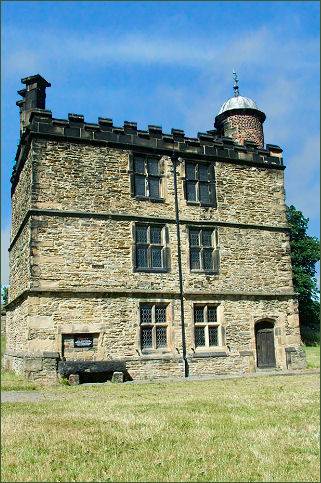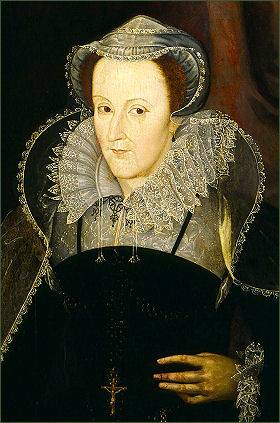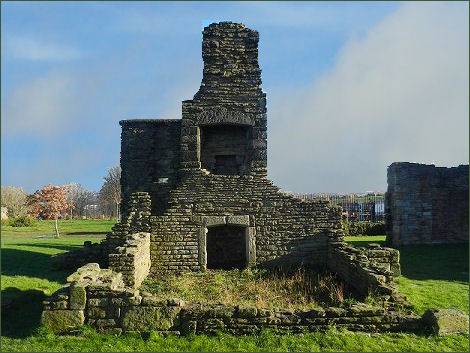Sheffield Manor Lodge
OS grid reference:- SK 375 865

 Historic Sheffield Manor Lodge is situated around a mile from Sheffield city centre, it was built around 1516 in what was then a large deer park to the east of Sheffield. The lodge was intended as the country retreat of George Talbot, 4th Earl of Shrewsbury and his wife, the famous Elizabethan Bess of Hardwick.
Historic Sheffield Manor Lodge is situated around a mile from Sheffield city centre, it was built around 1516 in what was then a large deer park to the east of Sheffield. The lodge was intended as the country retreat of George Talbot, 4th Earl of Shrewsbury and his wife, the famous Elizabethan Bess of Hardwick.
The remnant of the estate is now known as Norfolk Park.The remains include parts of the kitchens, long gallery, and the Turret House, also known as "Queen Mary's Tower", which contains fine seventeenth century ceilings.
Mary, Queen of Scots was imprisoned at both Sheffield Manor and Sheffield Castle. The Queen of Scots fled to England in 1568 to solicit aid from her cousin Elizabeth I, following her forced abdication from the Scottish throne, when she was replaced by her infant son James, she escaped from imprisonment and met with disastrous defeat at the battle of Langside by the Protestant Scottish lords.
Elizabeth, however, viewed her Catholic cousin, as a threat and a focus for rebellion in England. Mary was next in the line of succession to the English throne due to her direct descent from Margaret Tudor, elder sister of Elizabeth's father, Henry VIII.
Following the production of the Casket Letters in evidence against her, Mary was placed into the custody of George Talbot, 6th Earl of Shrewsbury, she was taken from Bolton Castle to Tutbury in Derbyshire in January of 1569. She was not closely guarded at first and plotted ceaselessly to gain her freedom with the help of the Duke of Norfolk and others of the Catholic nobility. The Queen of Scots was moved several times to places of greater safety and stricter control.
On 28 November 1570 Mary was taken to Tutbury Castle, where, apart from a few breaks at Chatsworth House and Buxton, and more regular visits to Sheffield and the Manor House, she remained for 14 years.
Two of Mary's letters are preserved in the Sheffield Archives. Thomas Howard, 4th Duke of Norfolk, Queen Elizabeth's maternal cousin and the wealthiest landowner in England, was found to be in collusion with the Florentine banker and ardent Catholic, Roberto di Ridolfi in a plot to marry Mary and lead a Catholic uprising to place her on the English throne and was consequently beheaded on 2 June 1572 at Tower Hill.
In 1582, while Mary was at Sheffield, an inventory of all the household goods and furniture belonging to George, Earl of Shrewsbury was drawn up. The inventory describes the castle and contents and provides a picture of the types of rooms in the castle at this time. These included a chapel, a porch going into the great hall from the great chamber , a wardrobe, the Lord's chamber and outer chamber, the Lady's chamber, a bakehouse, brewhouse, pantry, washhouse and low washhouse, a round tower, a square tower and a turret, round towers on either side of the gatehouse and walls running along the waterside, a porter's lodge, a dungeon, a square room, little kitchen, old kitchen, a kennel and a range of stables.
 Also included in the inventory is the "stuff" of the "Queen of Scots and her people". The list of rooms for Mary's servants includes those of the Master of the "quences howsholde", a Mr Burgon as her doctor and a Mr Jarvys as her "surgion".
The 1582 survey also lists the furnishings "in the hawle at the Poandes", now known as the Old Queen's Head.
Also included in the inventory is the "stuff" of the "Queen of Scots and her people". The list of rooms for Mary's servants includes those of the Master of the "quences howsholde", a Mr Burgon as her doctor and a Mr Jarvys as her "surgion".
The 1582 survey also lists the furnishings "in the hawle at the Poandes", now known as the Old Queen's Head.
In August 1584 Queen Elizabeth finally agreed to the Earl of Shrewsbury's petition releasing him from his duty of Mary's care. After leaving Sheffield, Mary was taken to Wingfield Manor in Derbyshire by her new gaoler, Sir Ralph Sadler, after again being involved in plots against Elizabeth she was executed for her involvement in the Babington Plot at Fotheringhay Castle on 8 February 1587.
Sheffield Manor later passed into the ownership of the Duke of Norfolk, by whom it was neglected, sold to tenant farmers, and largely dismantled in 1706. In 1953 the Duke of Norfolk Estate leased the site to Sheffield City Council for 999 years.
Sheffield Manor Lodge Discovery Centre is a purpose built education and visitors centre was part funded by the Heritage Lottery Fund. The centre displays exhibits which give an introduction to the rich heritage of Manor Lodge and has interactive databases for visitors to explore historical artefacts, people and activity associated with the site. There is also a community archive, resource library and texts related to the estate. . The Manor Cottages offer visitors the chance to discover what life on a 1940 farm was like.
Historic Buildings of Yorkshire
